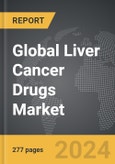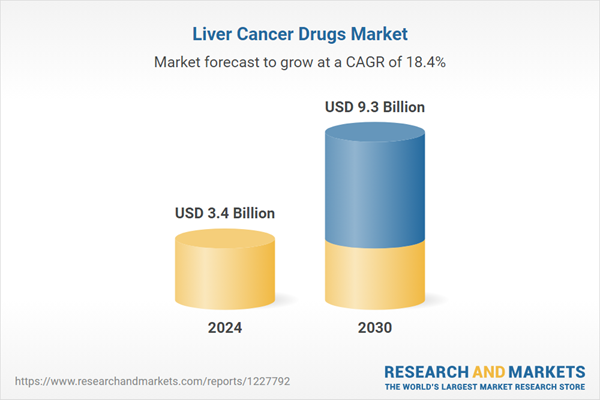The global market for Liver Cancer Drugs was valued at US$3.4 Billion in 2024 and is projected to reach US$9.3 Billion by 2030, growing at a CAGR of 18.4% from 2024 to 2030. This comprehensive report provides an in-depth analysis of market trends, drivers, and forecasts, helping you make informed business decisions. The report includes the most recent global tariff developments and how they impact the Liver Cancer Drugs market.
In recent years, immunotherapy has emerged as a groundbreaking approach in the treatment of liver cancer. Immune checkpoint inhibitors, such as pembrolizumab and nivolumab, have shown promise in enhancing the body’s immune response against cancer cells. These therapies work by blocking proteins that inhibit immune system activity, thus allowing T-cells to attack cancer cells more effectively. Additionally, combination therapies that integrate immunotherapies with targeted treatments or other modalities are being actively explored in clinical trials. The combination of atezolizumab and bevacizumab, for example, has demonstrated improved outcomes compared to traditional monotherapies. These advancements underscore a shift towards more personalized and effective treatment regimens, which not only aim to extend survival but also improve the overall quality of life for patients with liver cancer.
The growth in the liver cancer drugs market is driven by several factors. Firstly, the rising incidence of liver cancer, particularly in regions with high prevalence of hepatitis infections and NASH, has increased the demand for effective treatments. Secondly, technological advancements in drug development and genomic research have facilitated the discovery of novel therapeutic targets and the development of more effective drugs. Thirdly, the success of immunotherapies and targeted therapies has attracted significant investment in research and development, fostering a competitive and innovative market environment. Additionally regulatory agencies are providing accelerated approvals for breakthrough therapies, which helps expedite the availability of new treatments to patients. The increasing adoption of combination therapies, which offer synergistic effects and improved outcomes, further drives market growth. Furthermore, heightened awareness among healthcare providers and patients about the benefits of early diagnosis and advanced treatment options has led to a higher adoption rate of new drugs. Lastly, the expansion of healthcare infrastructure and access to advanced medical treatments in emerging economies is creating new opportunities for market growth, ensuring that innovative liver cancer therapies reach a broader patient population. These factors collectively contribute to the robust expansion and dynamic evolution of the liver cancer drugs market.
Segments: Therapy Type (Targeted Drug Therapy, Chemotherapy, Immunotherapy); Distribution Channel (Hospital Pharmacy, Retail Pharmacy, Online Pharmacy).
Geographic Regions/Countries: World; United States; Canada; Japan; China; Europe (France; Germany; Italy; United Kingdom; Spain; Russia; and Rest of Europe); Asia-Pacific (Australia; India; South Korea; and Rest of Asia-Pacific); Latin America (Argentina; Brazil; Mexico; and Rest of Latin America); Middle East (Iran; Israel; Saudi Arabia; United Arab Emirates; and Rest of Middle East); and Africa.
The analysts continuously track trade developments worldwide, drawing insights from leading global economists and over 200 industry and policy institutions, including think tanks, trade organizations, and national economic advisory bodies. This intelligence is integrated into forecasting models to provide timely, data-driven analysis of emerging risks and opportunities.
Liver Cancer Drugs - Key Trends and Drivers
Liver cancer drugs encompass a diverse range of therapeutic options aimed at treating hepatocellular carcinoma (HCC) and other malignancies of the liver. HCC, the most common type of primary liver cancer, often develops in the context of chronic liver diseases such as hepatitis B and C infections, non-alcoholic steatohepatitis (NASH), and cirrhosis. The treatment landscape for liver cancer has historically been challenging due to the complexity of the liver’s function and its vital role in the body’s metabolic processes. Traditional approaches, including surgery and localized therapies like transarterial chemoembolization (TACE), have been complemented by the advent of systemic treatments. Targeted therapies, such as sorafenib and lenvatinib, have been integral in managing advanced liver cancer by inhibiting specific pathways involved in tumor growth and angiogenesis. These drugs have provided significant survival benefits, although they are often associated with considerable side effects that can impact patients' quality of life.In recent years, immunotherapy has emerged as a groundbreaking approach in the treatment of liver cancer. Immune checkpoint inhibitors, such as pembrolizumab and nivolumab, have shown promise in enhancing the body’s immune response against cancer cells. These therapies work by blocking proteins that inhibit immune system activity, thus allowing T-cells to attack cancer cells more effectively. Additionally, combination therapies that integrate immunotherapies with targeted treatments or other modalities are being actively explored in clinical trials. The combination of atezolizumab and bevacizumab, for example, has demonstrated improved outcomes compared to traditional monotherapies. These advancements underscore a shift towards more personalized and effective treatment regimens, which not only aim to extend survival but also improve the overall quality of life for patients with liver cancer.
The growth in the liver cancer drugs market is driven by several factors. Firstly, the rising incidence of liver cancer, particularly in regions with high prevalence of hepatitis infections and NASH, has increased the demand for effective treatments. Secondly, technological advancements in drug development and genomic research have facilitated the discovery of novel therapeutic targets and the development of more effective drugs. Thirdly, the success of immunotherapies and targeted therapies has attracted significant investment in research and development, fostering a competitive and innovative market environment. Additionally regulatory agencies are providing accelerated approvals for breakthrough therapies, which helps expedite the availability of new treatments to patients. The increasing adoption of combination therapies, which offer synergistic effects and improved outcomes, further drives market growth. Furthermore, heightened awareness among healthcare providers and patients about the benefits of early diagnosis and advanced treatment options has led to a higher adoption rate of new drugs. Lastly, the expansion of healthcare infrastructure and access to advanced medical treatments in emerging economies is creating new opportunities for market growth, ensuring that innovative liver cancer therapies reach a broader patient population. These factors collectively contribute to the robust expansion and dynamic evolution of the liver cancer drugs market.
Report Scope
The report analyzes the Liver Cancer Drugs market, presented in terms of units. The analysis covers the key segments and geographic regions outlined below.Segments: Therapy Type (Targeted Drug Therapy, Chemotherapy, Immunotherapy); Distribution Channel (Hospital Pharmacy, Retail Pharmacy, Online Pharmacy).
Geographic Regions/Countries: World; United States; Canada; Japan; China; Europe (France; Germany; Italy; United Kingdom; Spain; Russia; and Rest of Europe); Asia-Pacific (Australia; India; South Korea; and Rest of Asia-Pacific); Latin America (Argentina; Brazil; Mexico; and Rest of Latin America); Middle East (Iran; Israel; Saudi Arabia; United Arab Emirates; and Rest of Middle East); and Africa.
Key Insights:
- Market Growth: Understand the significant growth trajectory of the Targeted Drug Therapy segment, which is expected to reach US$5.1 Billion by 2030 with a CAGR of a 18.4%. The Chemotherapy segment is also set to grow at 16.1% CAGR over the analysis period.
- Regional Analysis: Gain insights into the U.S. market, valued at $894.9 Million in 2024, and China, forecasted to grow at an impressive 24.3% CAGR to reach $2.3 Billion by 2030. Discover growth trends in other key regions, including Japan, Canada, Germany, and the Asia-Pacific.
Why You Should Buy This Report:
- Detailed Market Analysis: Access a thorough analysis of the Global Liver Cancer Drugs Market, covering all major geographic regions and market segments.
- Competitive Insights: Get an overview of the competitive landscape, including the market presence of major players across different geographies.
- Future Trends and Drivers: Understand the key trends and drivers shaping the future of the Global Liver Cancer Drugs Market.
- Actionable Insights: Benefit from actionable insights that can help you identify new revenue opportunities and make strategic business decisions.
Key Questions Answered:
- How is the Global Liver Cancer Drugs Market expected to evolve by 2030?
- What are the main drivers and restraints affecting the market?
- Which market segments will grow the most over the forecast period?
- How will market shares for different regions and segments change by 2030?
- Who are the leading players in the market, and what are their prospects?
Report Features:
- Comprehensive Market Data: Independent analysis of annual sales and market forecasts in US$ Million from 2024 to 2030.
- In-Depth Regional Analysis: Detailed insights into key markets, including the U.S., China, Japan, Canada, Europe, Asia-Pacific, Latin America, Middle East, and Africa.
- Company Profiles: Coverage of players such as 89bio, Alnylam Pharmaceuticals, Inc., AVEO Pharmaceuticals, Inc., Bristol-Myers Squibb Company, CSPC Innovation Pharmaceutical and more.
- Complimentary Updates: Receive free report updates for one year to keep you informed of the latest market developments.
Some of the 52 companies featured in this Liver Cancer Drugs market report include:
- 89bio
- Alnylam Pharmaceuticals, Inc.
- AVEO Pharmaceuticals, Inc.
- Bristol-Myers Squibb Company
- CSPC Innovation Pharmaceutical
- Double Bond Pharmaceutical
- Eli Lilly and Company
- Genoscience Pharma
- Gilead Sciences, Inc.
- Golden Biotechnology Corporation
Tariff Impact Analysis: Key Insights for 2025
Global tariff negotiations across 180+ countries are reshaping supply chains, costs, and competitiveness. This report reflects the latest developments as of April 2025 and incorporates forward-looking insights into the market outlook.The analysts continuously track trade developments worldwide, drawing insights from leading global economists and over 200 industry and policy institutions, including think tanks, trade organizations, and national economic advisory bodies. This intelligence is integrated into forecasting models to provide timely, data-driven analysis of emerging risks and opportunities.
What’s Included in This Edition:
- Tariff-adjusted market forecasts by region and segment
- Analysis of cost and supply chain implications by sourcing and trade exposure
- Strategic insights into geographic shifts
Buyers receive a free July 2025 update with:
- Finalized tariff impacts and new trade agreement effects
- Updated projections reflecting global sourcing and cost shifts
- Expanded country-specific coverage across the industry
Table of Contents
I. METHODOLOGYII. EXECUTIVE SUMMARY2. FOCUS ON SELECT PLAYERSIII. MARKET ANALYSISSOUTH KOREAREST OF ASIA-PACIFICARGENTINABRAZILMEXICOREST OF LATIN AMERICAIRANISRAELSAUDI ARABIAUNITED ARAB EMIRATESREST OF MIDDLE EASTIV. COMPETITION
1. MARKET OVERVIEW
3. MARKET TRENDS & DRIVERS
4. GLOBAL MARKET PERSPECTIVE
UNITED STATES
CANADA
JAPAN
CHINA
EUROPE
FRANCE
GERMANY
ITALY
UNITED KINGDOM
SPAIN
RUSSIA
REST OF EUROPE
ASIA-PACIFIC
AUSTRALIA
INDIA
LATIN AMERICA
MIDDLE EAST
AFRICA
Companies Mentioned (Partial List)
A selection of companies mentioned in this report includes, but is not limited to:
- 89bio
- Alnylam Pharmaceuticals, Inc.
- AVEO Pharmaceuticals, Inc.
- Bristol-Myers Squibb Company
- CSPC Innovation Pharmaceutical
- Double Bond Pharmaceutical
- Eli Lilly and Company
- Genoscience Pharma
- Gilead Sciences, Inc.
- Golden Biotechnology Corporation
Table Information
| Report Attribute | Details |
|---|---|
| No. of Pages | 277 |
| Published | April 2025 |
| Forecast Period | 2024 - 2030 |
| Estimated Market Value ( USD | $ 3.4 Billion |
| Forecasted Market Value ( USD | $ 9.3 Billion |
| Compound Annual Growth Rate | 18.4% |
| Regions Covered | Global |









